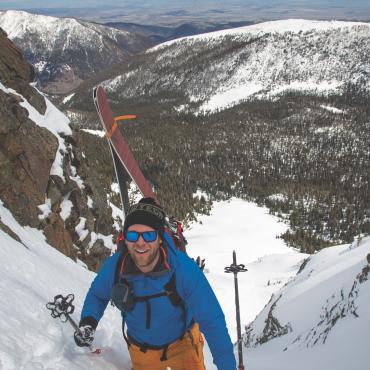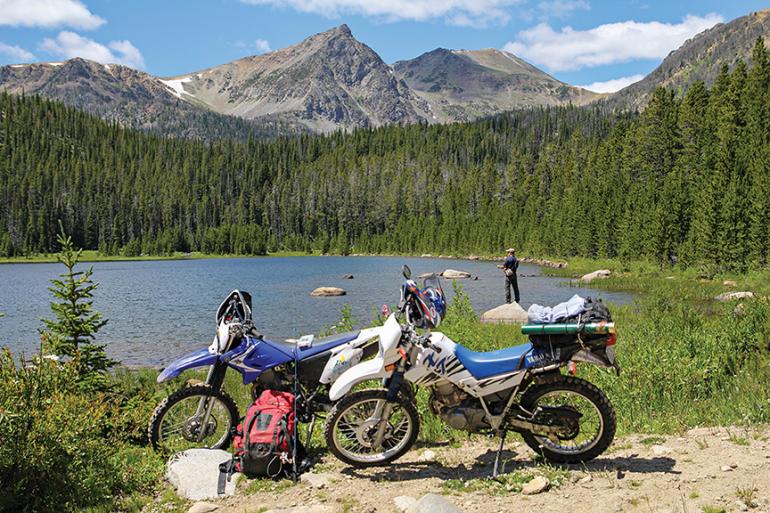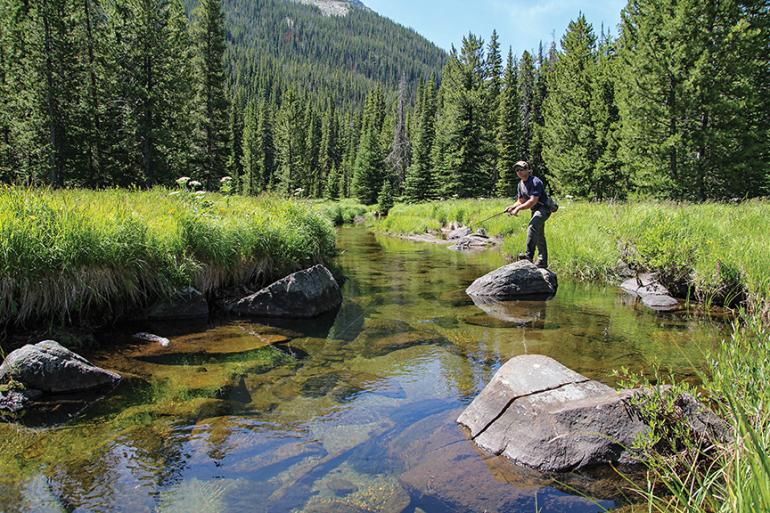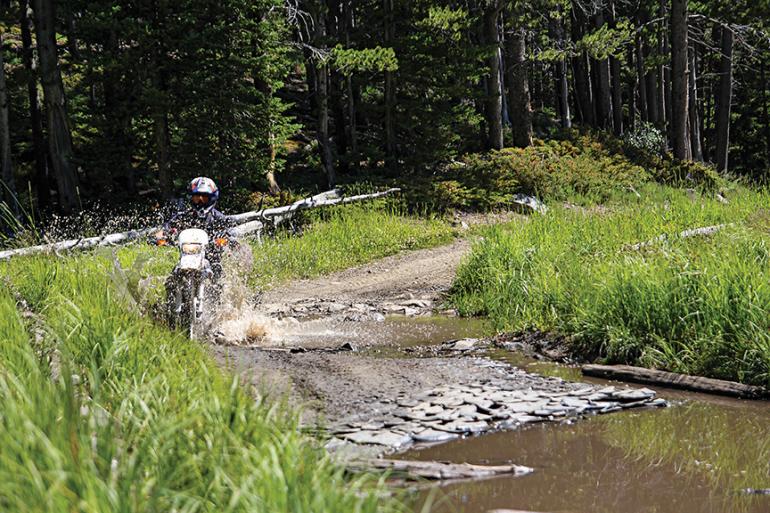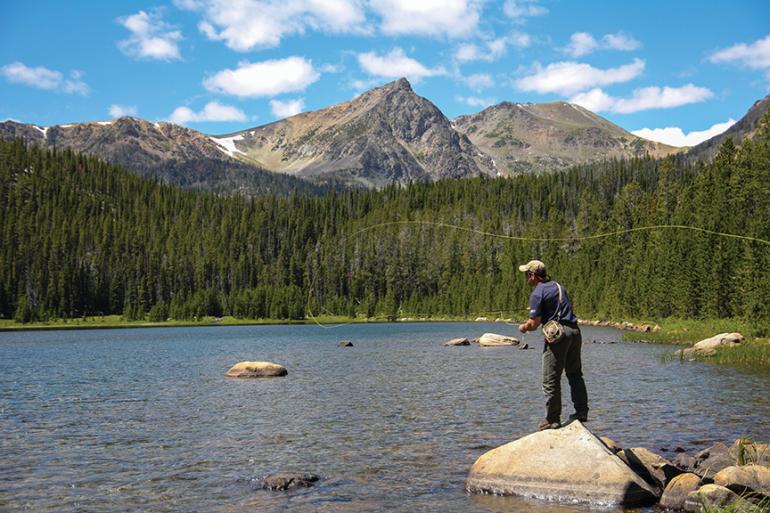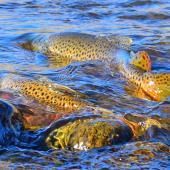A Balanced Line
Backcountry fishing by motorbike.
There’s something satisfying about defying convention, juxtaposing dissimilar experiences, and coming away with something new. And there are few things more dissimilar than fishing and riding dirtbikes. Fishing is quiet, slow, and meditative. Grabbing a handful of throttle on a chunk-tired, long-travel motorcycle is anything but—it’s loud, fast, and reactive. But combining these two experiences can provide access to some of southwest Montana’s most remote high-altitude lake and stream fishing, with an added element of adrenaline. The trick, in moto-fishing as in life, is to ride a balanced line—sometimes quite literally.
The bike is heaving and bucking beneath me like an obstinate mule, and I can’t decide if I’m having fun. O/B publisher Mike England and I are a few miles into our inaugural moto-fishing experiment, following a trail marked on the map as a 4x4 road toward a pair of lakes known to contain copious quantities of rainbow and cutthroat trout. The only problem is that the “trail” has turned out to be an eroded boulder field, interrupted by deep mud holes excavated by monster trucks. I’m in second gear, pinning the bike over knee-high boulders like a trials rider and trying to remember if I opted for rental insurance. I stop at the top of a particularly challenging pitch—40 yards of football-sized loose rocks scattered between enormous bedrock outcrops—to wait for Mike and catch my breath.
The plan was simple: choose a local mountain range with streams and lakes accessible only by long walks or dirtbike, and then go exploring. We planned to base from the truck at a central location, enjoying all of the comforts of car camping, then ride to new, remote water each day with our rods lashed to our bikes. Luckily for us, southwest Montana has no shortage of mountains conducive to this style of moto-fishing. This kind of experience is possible in many parts of the Absarokas, Gravellys, Big Belts, Little Belts, Castles, Elkhorns, Pioneers—the list goes on. But we chose the Tobacco Roots for their proximity, and because we know them well. And because we’re lazy. We’re using dirtbikes to go fishing, remember?
I hear Mike before I see him, a few hundred yards back down the trail. His engine revs irregularly, crescendos, and then stalls. I hear murmured cursing before the cyclical whirring of the electric starter coaxes his engine back to life and the revving resumes. He jostles into view, bouncing over the terrain like a sprung Jack-in-the-Box, correcting one way, then the other, as rocks give way beneath his tires. He reins it in next to me and kills the engine. “This is ridiculous,” he says. “What the hell are we doing?”
The bikes we’re using on this adventure are 250cc trail bikes, ideally suited for low-impact backcountry access (Mike’s is even street-legal). With low standover height, we can put both feet flat on the ground from a seated position—key for safety and stability when moving slowly over rough terrain. At the very least, they make it easier to jump off when shit hits the fan. And with quiet, air-cooled engines that put out modest power, and narrow-ratio transmissions that harness that power in a controlled way, these bikes are far from the snorting, fire-breathing motocross machines that churn singletrack into ruts and echo obnoxiously through the mountains.
We’ve seen a few of those in the course of our ride, their brightly armored riders on the edge of control, spinning their wheels and roosting rocks and mud like they’re filming for Red Bull. It’s precisely that kind of behavior we’re trying to avoid: we want to use the bikes as effective tools, without hurting the trails we share with everyone else, or the waterways we aim to fish. Nor do we want to scare the bejesus out of hikers ambling along enjoying the sounds of nature.
After a brief break, we continue slowly up the boulders to a hairpin where a beautiful creek spills through meadows ringed by peaks. This is why we’re here. We dismount and assemble our rods in the shade of an enormous fir, then walk upstream through tall, midsummer grass. We pass a trampled area where a herd of deer recently bedded down, and a pile of fresh, moist moose droppings. Mike leaps onto a rock in the center of the creek and gently places a short cast into a downstream riffle. In the gin-clear water, we watch as a half-dozen small trout investigate the offering, but none commit. I halfheartedly make a few casts, but don’t care if I catch a thing. The stream, the trout, the mountains, our position—it’s perfectly beautiful.
I’m one of many Bozemanites conflicted over motorized recreation. As a hiker, biker, fisherman, and Wilderness lover, I tend to prefer my outdoors quiet and lonely—much like the stream meadow where Mike and I find ourselves. But there’s an undeniable appeal to covering a lot of ground with relatively little effort—plus, riding motorcycles (on road or off) is Type 1 fun. No arguments here.
We’re not breaking any laws; we’re trying to be as respectful to the trail and other trail users as possible; we’re just doing what lots of other people are doing. And we’re having a pretty good time. But there’s still something that bothers me about firing up the dirtbikes in a place like this. It’s a little like rollerblading in the Vatican.
After 40 minutes of exploring the small oxbows of the stream, we make our way back to the trail and our bikes. Miles further up the trail, there are lakes where we have been told the fishing can be excellent. With a renewed sense of purpose, we thump away, and resume our weaving, bouncing boulder-climb. I’m getting the hang of this kind of riding, but in a matter of minutes, the constant pounding begins numbing my hands and torching my lower back once more. I enjoy the challenge, but just want to get off the bike and go fishing.
Finally, after a tricky stream crossing over algae-slicked rocks, we arrive at the first lake. As we assemble our gear, we acknowledge that the ride was somewhat less than awesome, but we’d be arriving hours later had we hiked in—an interesting tradeoff. The water has a bit of chop from an afternoon breeze, but the temperature is pleasant, and we immediately set to fishing. I walk the shore clockwise, Mike works it counterclockwise, and we both catch fish. Lots of fish. Or maybe they’re the same two fish, over and over—they’re all the same size—but it doesn’t matter. It’s a perfect summer day in the high country, with a fresh, cooling breeze in my face, the sound of water slapping shore, and a fish on my line.
We fish for nearly two hours and catch dozens of rainbows each before regrouping at the bikes for lunch. My sense of aesthetic has been restored, and I’m enjoying the moment, when I hear the unmistakable revving of motors. A pair of ATVs tears out of the forest and splash across the creek, followed by a lumbering lifted Jeep, clanking its skidplates over the rocks. They wave and smile, and continue up the trail toward the next lake. They’re friendly and courteous, and aren’t abusing the trail—acting every bit the part Mike and I aspire to—and yet, their presence kills the peace of the moment. It makes me realize that the impact of these kinds of machines in places like this cannot be measured by standards of pollution or erosion but by their inherent position opposite the natural world. Never will there be a spectacular Planet Earth special called “Montana by Dirtbike.” It’s an observation I make while preparing to fire up my own bike again, and the irony isn’t lost on either of us. We finish lunch and pack up: there’s one more lake on the itinerary today.
After a couple of wrong turns and at least one minor crash, we find ourselves on the roughest stretch of trail yet. It’s steep, badly eroded, and freshly churned by a Jeep or truck with enormous tires. After narrowly avoiding a nasty crash, Mike decides he’s had enough. After all, we still have to go down the entire horrible trail we came up. We pick our way down, idling the bikes through sections that we ascended at full throttle. When we hit a graded USFS road, it feels like Interstate highway, and we tool casually back toward camp, feeling in complete control as a result of feeling so out of control for most of the day.
There’s one final steep downhill section before camp. It’s loose and shady, with many small rocks and gravel. I’m rounding the last switchback when I hear Mike go down. With an understated sputter and skid, his bike slides off the downhill side of the trail and crashes into a small tree. Luckily, he bails early, and bounces up immediately, angry and frustrated, “Damnit! I lost the front tire off the edge—there’s nothing you can do when it slides like that!” He scoots down the bank, rights his bike, and with some difficulty rolls back onto the loose trail with a new battle scar: a broken rear signal. But getting bucked on the narrow, steep, boulder-strewn trail could’ve been much, much worse. This is the most dangerous “fishing” I’ve ever done.
Ten minutes later, we roll into camp and park the bikes away from the firepit. In the truck, there’s a cooler full of beer, venison sausages, and fresh salad. It’s a far cry from what we’d be carrying on our backs if we were hiking and camping at the lake. For entertainment, we practice our BB-gun marksmanship until darkness forces us fireside. Sitting in comfy camp chairs, wearing warm jackets against the clear mountain chill, we pore over the map and plan the next day. Which streams look inviting? Which lakes are within range? On the bikes, our reach is limited only by fuel and riding skill.
As we drift to sleep, I think about the day—and the balance we’re trying to strike. The dirtbikes present an interesting quandary. We can roam wide and fish freely at numerous lakes and streams in one day with minimal physical exertion (unless you count sore hands and backs). But the bikes are expensive, dangerous, and ultimately diminish the wild feel of any place they’re present—which is, ultimately, the point of backcountry fishing.
By contrast, hiking to fish is time-intensive, lots of work, usually limited to one destination in a day, and rarely do I drink beer, eat fresh salad, and fall asleep on a legitimate mattress while backpacking. But the spell of the lakes and mountains is never broken by the industrial march of internal combustion.
There is no right or wrong, just plenty to think about as I close my eyes and settle into sleep. At the very least, I have a new appreciation for technical mountain riding—and for quiet, wild waters. And of all the crazy lines we rode today, this is the hardest one to balance.

